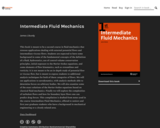
Short Description:
This book is meant to be a second course in fluid mechanics that stresses applications dealing with external potential flows and intermediate viscous flows. Students are expected to have some background in some of the fundamental concepts of the definition of a fluid, hydrostatics, use of control volume conservation principles, initial exposure to the Navier-Stokes equations, and some elements of flow kinematics, such as streamlines and vorticity. It is not meant to be an in-depth study of potential flow or viscous flow, but is meant to expose students to additional analysis techniques for both of these categories of flows. We will see applications to aerodynamics, with analysis methods able to determine forces on arbitrary bodies. We will also examine some of the exact solutions of the Navier-Stokes equations based on classical fluid mechanics. Finally we will explore the complexities of turbulent flows and how for boundary layer flows one can predict drag forces. This compilation is drafted from notes used in the course Intermediate Fluid Mechanics, offered to seniors and first year graduate students who have a background in mechanical engineering or a closely related area. Data Dashboard
Word Count: 105137
(Note: This resource's metadata has been created automatically by reformatting and/or combining the information that the author initially provided as part of a bulk import process.)
- Subject:
- Applied Science
- Engineering
- Physical Science
- Physics
- Material Type:
- Textbook
- Provider:
- Oregon State University
- Author:
- James Liburdy
- Date Added:
- 11/18/2021